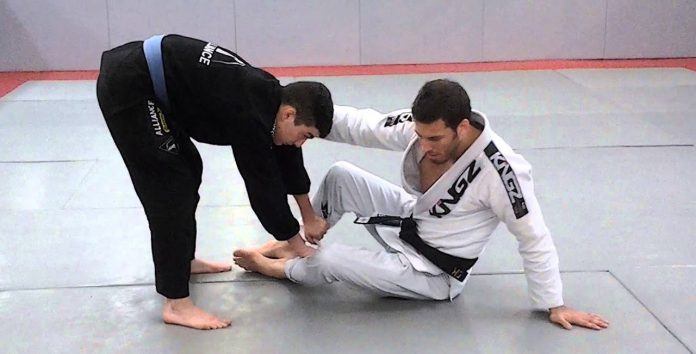
There are certain techniques in Brazilian Jiu-Jitsu that we all hate. Just as much as people that are on top get annoyed with the worm guard (and all lapel guards fro that matter) so do folks that play guard frown at the Toreando pass. It is a speed pass, that also ahs pressure components and has really superior mechanics. In other words, it is one of those nightmares passes that you’ll hate from the bottom of your heart. Especially if you train regularly with the Gi. That said, like everything else in BJJ, there are solutions for the BJJ Toreando pass, you just need to know where to look. Like this article, for example.
The one thing to understand about the BJJ Toreando pass is that there’s no move out there that will keep you safe 100% once the pass starts happening. If you enter in a battle against the Toreando heed on, you’ll end up passed, and stretched out each and every time. Instead, you need to either act early, and set up a trap or two or let it unfold, and execute a counter or a block very late in the process. In order to achieve both, you’ll need to know how the pass itself works.
Figuring The BJJ Toreando Pass Out
The Toreando pass is a weird one. It is not really a loose pass, nor is it a tight pressure pass. it is some weird combination of both. It is very technical and will work for everyone. However, explosive grapplers, like wrestlers for example, really do end up having crazy amounts of success with it because executing it quickly and with power really does make a difference.
Even though the BJJ Toreando pass works in both GI and No-Gi, it is much more difficult to deal with when you’re wearing a Gi. This is exactly the version of the Toreando you need to figure out, in order to be able to prevent both Gi and No-Gi attacks.
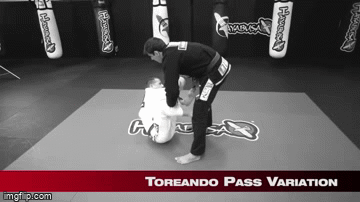
What follows is the pressure part of the Toreando pass. That is when you place your shoulder on the opponent’s belly and stay there, keeping them stuck and bearing all your weight on top. Plenty of other details, like having a stiff arm on the near side, switching the hips, etc. make the pass even more terrible. Plus, there are several different variations of it, in terms of grips, leg placement, motion, etc.
What Are Your Options?
As I mentioned previously, once you know the strengths of the BJJ Toreando pass, you can easily exploit the few weak spots in the chain of motion. Those weak spots appear either very early in the pass, or extremely late. Along the middle, you can just sit back and absorb the pressure, because everything you do will lonely put you in more peril.
The first “hole’ that the Toreando pass has is that it ties the top person’s arms up with the pants grips .that means you can place grips of your own, that will help you deal with the pass, either before it gets going, or right before they complete it. Another thing that goes in your favor is the power of your legs. While the opponent can control them, if you can make them heavy and put them in a certain configuration, it will make their task really hard, blocking them for long enough to mount a counter.
With all that in mind, there are three things you can do from guard when defending the Toreando pass: force them back, choke them, or sweep them. Here’s how:
-
Force Them Back
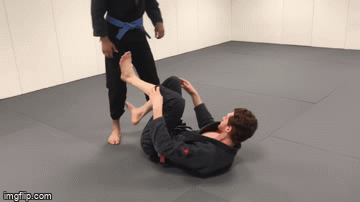
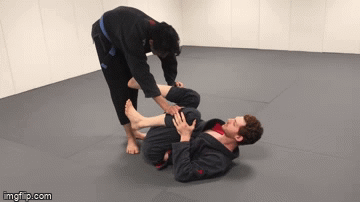
-
Choke ‘Em Out
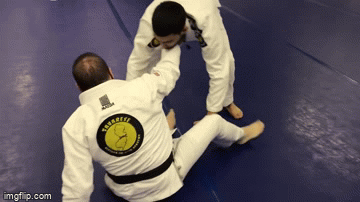
-
Sweep Counter
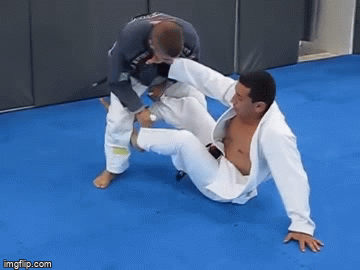
Closing Thoughts
Understanding the offensive part of any BJJ move is the foundation of making defenses and counters work. With the BJJ Toreando pass, all the danger comes from the manipulation of the legs. However, you get grips for free, and as long as you plant them smartly (biceps, near side sleeve, or cross collar) you’ll be able to prevent the pass early, or even get out of it very, very late. have fun with the three options above and feel free to add-in your own.


![Darce Choke Encyclopedia – Origins, Mechanics and Variations [2025] BJJ, choke, Brabo, BJJ Darce Choke, D'arce Choke, Darce BJJ Choke](https://bjj-world.com/wp-content/uploads/2017/11/JungPoirierLeeYahoo-218x150.jpg)









![Closet Closed Guard Craig Jones DVD Review [2025] Closet Closed Guard Craig Jones DVD Review](https://bjj-world.com/wp-content/uploads/2025/03/closet-closed-guard-craig-jones-dvd-review-218x150.png)
![Xanadu Back Takes Levi Jones-Leary DVD Review [2025] Xanadu Back Takes Levi Jones-Leary DVD Review](https://bjj-world.com/wp-content/uploads/2025/03/xanadu-back-takes-levi-jones-leary-dvd-review-218x150.png)

![No-Gi Grapplers Guide To Front Headlock Joel Bane DVD Review [2025] No-Gi Grapplers Guide To Front Headlock Joel Bane DVD Review](https://bjj-world.com/wp-content/uploads/2025/03/no-gi-front-headlock-joel-bane-dvd-review-218x150.png)

![Get Off My Legs Gringo Craig Jones DVD Review [2025] Get Off My Legs Gringo Craig Jones DVD Review](https://bjj-world.com/wp-content/uploads/2025/03/get-off-my-legs-gringo-craig-jones-dvd-review-218x150.png)
![Countering Triangles And Omoplatas Adam Mazin DVD Review [2024] Countering Triangles And Omoplatas Adam Mazin DVD Review](https://bjj-world.com/wp-content/uploads/2024/10/countering-triangles-and-omoplatas-adam-mazin-dvd-REVIEW-324x235.png)
![The Buchecha Gi Takedown System DVD Review [2025] The Buchecha Gi Takedown System DVD Review](https://bjj-world.com/wp-content/uploads/2025/01/buchecha-gi-takedown-system-dvd-review-100x70.png)
![BJJ Foundations Mikey Musumeci DVD Bundle Review [2024] BJJ Foundations Mikey Musumeci DVD Bundle Review](https://bjj-world.com/wp-content/uploads/2024/09/bjj-foundations-mikey-musumeci-dvd-bundle-review-100x70.png)
![Essential Shin To Shin System Shawn Williams DVD Review [2025] Essential Shin To Shin System Shawn Williams DVD Review](https://bjj-world.com/wp-content/uploads/2025/01/shin-to-shin-system-shawn-williams-dvd-review-100x70.png)
![Upper Body Chain Attacks Janine Mocaiber DVD Review [2025] Upper Body Chain Attacks Janine Mocaiber DVD Review](https://bjj-world.com/wp-content/uploads/2025/03/upper-body-chain-attacks-janine-mocaiber-dvd-review-100x70.png)
![Trip Throw Dilemma Michael Pixley and Heath Pedigo DVD Review [2024] Trip Throw Dilemma Michael Pixley and Heath Pedigo DVD Review](https://bjj-world.com/wp-content/uploads/2024/10/trip-throw-dilemma-michael-pixley-dvd-review-100x70.png)

![Mastering The Crucifix Alexandre Pereira DVD Review [2025] Mastering The Crucifix Alexandre Pereira DVD Review](https://bjj-world.com/wp-content/uploads/2025/01/mastering-the-crucifix-alexandre-pereira-dvd-review-100x70.png)
![Get Off My Legs Gringo Craig Jones DVD Review [2025] Get Off My Legs Gringo Craig Jones DVD Review](https://bjj-world.com/wp-content/uploads/2025/03/get-off-my-legs-gringo-craig-jones-dvd-review-100x70.png)
![Woj Lock the World Chris Wojcik Ankle Locks DVD Review [2024] Woj Lock the World Chris Wojcik Ankle Locks DVD Review](https://bjj-world.com/wp-content/uploads/2024/12/woj-lock-the-world-chris-wojcik-dvd-review-100x70.png)




![Total Domination Top Control Mariusz Domasat DVD Review [2024] Total Domination Top Control Mariusz Domasat DVD Review](https://bjj-world.com/wp-content/uploads/2024/09/domination-top-control-mariusz-domasat-dvd-review-100x70.png)
![Spider and Lasso Guard Jared Welman DVD Review [2025] Spider and Lasso Guard Jared Welman DVD Review](https://bjj-world.com/wp-content/uploads/2025/01/spider-and-lasso-guard-jared-welman-dvd-review-100x70.png)
![Best Marcelo Garcia Techniques by Team Marcelo Garcia DVD Review [2025] Best Marcelo Garcia Techniques by Team Marcelo Garcia DVD Review](https://bjj-world.com/wp-content/uploads/2025/02/best-marcelo-garcia-techniques-dvd-review-100x70.png)
![Two Sides One Game Sweep and Pass Marcos Tinoco DVD Review [2024] Two Sides One Game Sweep and Pass Marcos Tinoco DVD Review](https://bjj-world.com/wp-content/uploads/2024/11/sweep-and-pass-marcos-tinoco-dvd-review-100x70.png)


![The Closed Guard Malachy Friedman BJJ DVD Review [2025] The Closed Guard Malachy Friedman BJJ DVD Review](https://bjj-world.com/wp-content/uploads/2025/01/closed-guard-malachy-friedman-bjj-dvd-review-100x70.png)




![Modern Split Squat Passing Jason Rau DVD Review [2024] Modern Split Squat Passing Jason Rau DVD Review](https://bjj-world.com/wp-content/uploads/2024/11/modern-split-squat-passing-jason-rau-dvd-review-100x70.png)
![Systematically Attacking The Crucifix Gordon Ryan DVD Review [2024] Systematically Attacking The Crucifix Gordon Ryan DVD Review](https://bjj-world.com/wp-content/uploads/2024/10/systematically-attacking-the-crucifix-gordon-ryan-dvd-review-100x70.png)

![Heavy Top Game Fabiano Scherner BJJ DVD Review [2025] Heavy Top Game Fabiano Scherner BJJ DVD Review](https://bjj-world.com/wp-content/uploads/2025/01/heavy-top-game-fabiano-scherner-bjj-dvd-review-100x70.png)